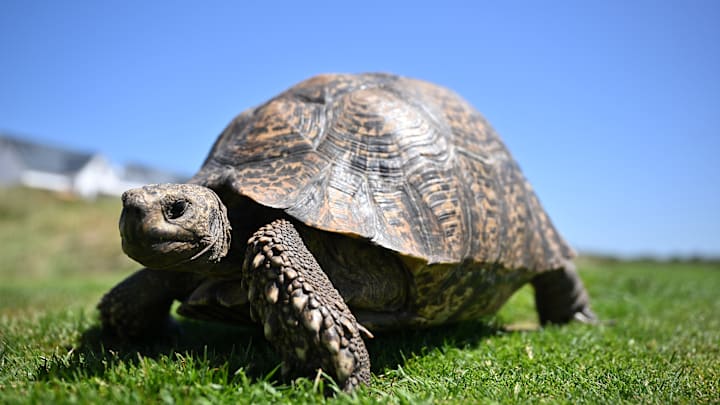Celebrate the ultimate slow and steady land reptile with these fun facts about tortoises.
1. A tortoise is a turtle, but a turtle isn't a tortoise.
A turtle is any shelled reptile belonging to the order Chelonii. The term "tortoise" is more specific, referring to terrestrial turtles. (Of course, there's always an exception. In this case, the land-dwelling box turtle.) Tortoises are usually herbivorous and can't swim.
One easy way to tell them apart: look at their feet and shells. Water turtles have flippers or webbed feet with long claws, and their shells are flatter and more streamlined. Tortoises have stubby, elephant-like feet and heavier, domed shells.
2. A group of tortoises is called a creep.
But you won't see a creep very often. (Not that kind, anyway.) Tortoises are solitary roamers. Some mother tortoises are protective of their nests, but they don't care for their young after they hatch.
3. Tortoises inspired the ancient Roman military.
During sieges, soldiers would get in testudo formation, named after the Latin word for tortoise. The men formed rows and held shields in front or above them to completely shelter the unit.
4. "Testudinal" means "pertaining to or resembling a tortoise or tortoise shell."
Go ahead. Compliment your friend's testudinal sunglasses.
5. Tortoises have an exoskeleton and an endoskeleton.
The shell has three main parts: the top carapace, the bottom plastron, and the bridge that fuses these pieces together. You can't see them, but every tortoise has ribs, a collar bone, and a spine inside its shell.
6. The scales on the carapace are called scutes.
Made of the same keratin found in fingernails and hooves, scutes protect the bony plates of the shell from injury and infection. The growth rings around scutes can be counted to determine the approximate age of wild tortoises.
7. The lighter the shell, the warmer the origin.
Tortoises from hot places tend to have lighter-colored shells than tortoises from cooler areas. The light tan sulcata originates from the southern part of the Sahara Desert.
8. They can't swim, but tortoises can hold their breath for a long time.
They're extremely tolerant of carbon dioxide. It's a good thing—tortoises have to empty their lungs before they can go into their shells. You'll often hear them exhale when they're startled and decide to hide.
9. And yes, their shells are sensitive to touch.
Shells have nerve endings, so tortoises can feel every rub, pet, or scratch...and sometimes they love it.
10. Sulcatas are one of the most popular pet tortoises—and one of the biggest.
Get ready to move to the suburbs and amend your will. Sulcatas are the third largest tortoise species in the world, behind the Galapagos and Aldabra giant tortoise. They can live more than 100 years and weigh up to 200 pounds.
11. Charles Darwin and Steve Irwin cared for the same tortoise, a Galapagos gal named Harriet.
Darwin is said to have collected and named Harriet back in 1835. She was sent to England and eventually wound up at Australia Zoo, founded by Steve Irwin's parents. She finally passed on in 2006, the same year as the Crocodile Hunter's fatal encounter with a stingray.
12. Tortoises reach sexual maturity with size, not age.
You won't be able to tell a tortoise's sex until it reaches a certain size, which varies by breed. The most obvious tell is the plastron—for mating purposes, it's flatter on females and curved on males. Males also tend to be larger and have longer tails.
If you're a tortoise owner who prefers surprises, just wait for your pet to come out of his or her shell. Males will eventually display their private parts while soaking. And it's not uncommon for females to lay eggs, even without a mate to fertilize them.
13. They're the ultimate conservationists.
Tortoises can extract water and nutrients from even the most paltry bites. Their hindgut system works like a double digestive tract, separating water from their waste. When water's scarce, they'll hang on to water waste and simply excrete the urates, which look like white toothpaste.
14. They can smell with their throats.
Like other reptiles, tortoises detect the faintest of smells with the vomeronasal organ, or Jacobson's Organ, on the roof of their mouths. Instead of flicking their tongues, they pump their throats to circulate air through the nose and around the mouth.
15. Tortoises won the space race.
In 1968, the Soviet Union's Zond 5 spacecraft was the first to circle the moon and return safely to Earth. The tortoises on board lost about 10 percent of their body weight, but were still ready for a meal when they touched down. That's one giant step for tortoisekind.
16. They might be smarter than we thought.
Slow and steady won the race in 2006 when scientist Anna Wilkinson placed a tortoise and rat in the same maze. The reptile was better at navigating the maze to find food, making sure it didn't revisit the same area twice. When cognitive landmarks were removed for a second trial, the tortoise systematically visited each section of the maze to find food. The rat wasn't as methodical. Previous research hasn't shown tortoises to be so clever, though: Wilkinson suspects cold lab temperatures are to blame. Later research found that tortoises use gaze-following to learn from the behavior of other animals.
